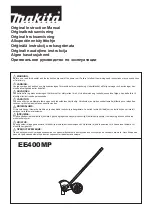
15
Krisis KARRE - User’s manual
An uncontrollable, partially open surface of the main glider always has a disadvantageous effect on
the flight characteristics of the reserve parachute. This also applies to all non-steerable systems,
which is why it is generally advisable to use separation carabiners instead of conventional
carabiners.
Resolving twists
If the paraglider is disconnected, even multiple twists can be resolved quickly and easily with the
right technique. By making leg kicks in an upright position (slow in one direction, fast in the other),
the pilot turns about 90° per stroke in the desired direction. This technique is standard in skydiver
training, and should be practiced on a suspension using the reserve attachment points at the
harness.
While resolving twists, the pilot should look upwards to the reserve and check whether the leg kicks
are made in the right direction for the respective direction of rotation. If necessary, the direction of
the leg kicks and thus the direction of rotation must be changed.
Spiraling
The
KRISIS KARRE
can be steered using the brake loops on the rear risers. This is most effective
when one side is pulled through quickly and to full deflection to fly a turn. After about five seconds,
the brake can be released briefly to resume full speed. Then it can be pulled fully again for
directional correction. With this method, the canopy turns into the curve most quickly and in a
defined manner.
The control forces of the
KRISIS KARRE
are relatively high and the system reacts much slower to
direction changes than a paraglider. There is no danger of a stall - not even with impulsive and deep
control inputs at the brakes.
Flyback
By pulling the brake loops fully on both sides, the canopy can be brought into a “flyback“. The
reserve will then fly backwards until the brakes are released.
Side slip
By holding one brake long and far down, the
KRISIS KARRE
can also be brought into a “side slip”.
The reserve then pushes stably over one of the two lateral corners. This flight state is terminated by
counter-braking and releasing. The side slip can be helpful to avoid obstacles or to turn just above
ground still against the wind. Pulling the brake too deep or too hard will not cause a stall, which is
very important for the pilot’s safety, especially in stress situations.
Landing approach
The KRISIS KARRE minimized sink rate resulting from its canopy trim gives the pilot more time to
prepare for landing and provides optimal conditions for an injury-free landing. The flight tests have
shown that the
KRISIS KARRE
is best landed when the approach and landing are done completely
unbraked.
















































